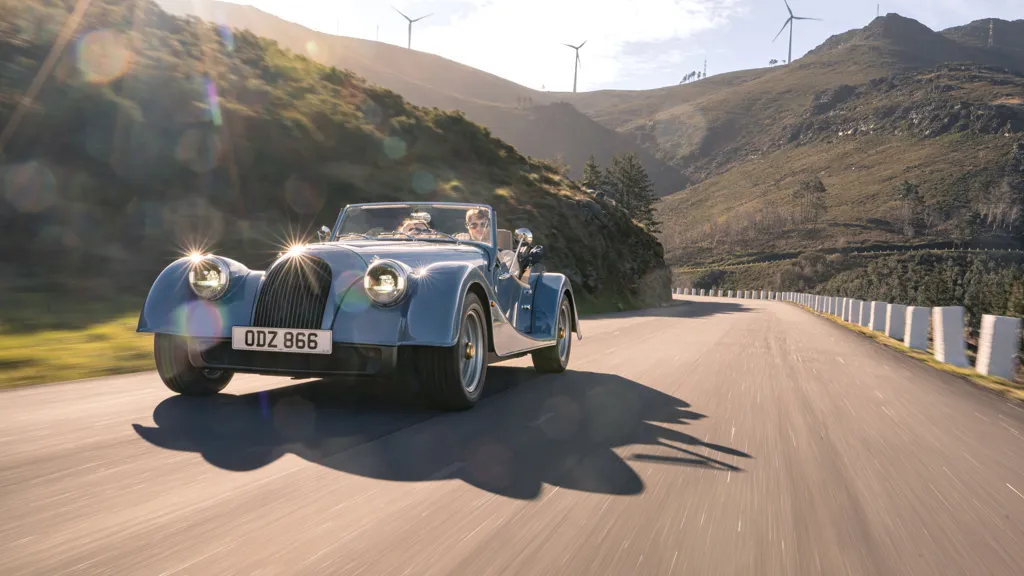An English company has been producing handmade sports cars for more than 100 years. The new model looks very much like the old ones.
Chevrolet wrings a lot of mileage out of the fact that its Suburban holds the record for continuous production of any vehicle model. Ninety years is impressive for any nameplate.
However, during that time, the Suburban has been produced in 12 different generations, and if it were possible to bear less than zero resemblance to something, one could say that about the current generation of Suburban in relation to the 1935 original. The two vehicles are far from twins.
The Morgan Motor Company of Malvern, England, on the other hand, released its sports car, the 4/4, in 1936, a year after the Suburban, and the design has not changed that radically. The boutique manufacturer's current model, the Plus Four, still bears a resemblance to its ancestor, and in spite of any import tariff, there's a six-month waiting list to get one of these hand-built cars.
And as collectibles, the cars, which start at about $85,000 new, seem to hold their value compared with some other old British brands. In two online auctions this year, for example, Morgan prices hit $55,000 (for a 2001 model with 25,000 miles) and $60,000 (for a 2005 roadster with one owner).
"Values of older Morgans have increased about 13 percent over the last 10 years" said Andrew Newton, senior auction editor for the automotive lifestyle brand Hagerty. "Values haven't increased with the market in general, but Morgans are doing better than cars from defunct British sports car brands like Triumph and Austin-Healey."
Morgans are like classic older structures that have been seemingly unchanged, but have been modernized over the years, like the Bradbury Building in Los Angeles and New York's Chrysler Building. Things like HVAC, elevators, and fire detection and suppression have been updated, and so have the elements and features of the Morgan.
Outwardly, its new Plus Four is nearly indistinguishable from those built after 1953; in fact, the latest model is quite similar to sports cars built in the 1930s. But inside the Plus Four, there is modern chassis construction, air-conditioning and a turbocharged BMW engine. Roll-up windows, however, are still a bridge too far for Morgan, which uses removable side screens instead.
Morgan, which was founded in 1910, "is the oldest independent car company that has been in continuous manufacture," Matthew Hole, the company's managing director, said in an interview.
And by continuous, Mr. Hole means continuous. Morgan was one of the few car companies that built vehicles during the world wars. Since about 1970, however, Morgan's presence in the United States has been sporadic at best. After 1967, the cost and difficulty in complying with ever-increasing testing requirements to meet federal emission and safety standards started to become overwhelming for the small, boutique manufacturer.
Dealers and devotees in the United States tried a number of things to keep new Morgans available, from converting the cars to run on propane, to importing cars without engines (owners would install their own). All of this was done to avoid emission certification laws.
Then, because of a law passed in 2015 that exempts low-volume manufacturers from some safety and emissions regulations, Morgan was eventually able to sell new cars in the United States for the first time in many years.
Under the 2015 Fixing America's Surface Transportation Act, low-volume manufacturers can sell up to 325 examples of cars that outwardly resemble cars manufactured at least 25 years ago without having to comply with crash standards, as long as they can use engines that meet current emission regulations. It is the Morgan Plus Four's resemblance to its ancestors that were first built in the 1930s that cinched the deal, along with cooperation from BMW in supplying an emission-compliant engine and transmission package.
But it still wasn't simple. A large part of emission compliance is handled by an onboard diagnostic system, and the same system that will work for a 2.0-liter turbocharged BMW four-cylinder engine when it's powering a new 3 Series won't work in a lighter Morgan.
According to Mr. Hole, the company had to create its own software and onboard diagnostic system for the Plus Four, and it was done in-house. The Plus Four is now emissions compliant in 49 states, and Mr. Hole said he believed that approval from the California Air Research Board would be forthcoming.
It is exceedingly rare for Morgan to build two cars that are exactly alike. The vehicles are still hand crafted, using some techniques that date from 19th-century coach-building. While the car's chassis is bonded aluminum, the body is made from an ash wood frame covered with hand-hammered aluminum body panels.
"Forty percent of the cars we built last year left with things not even on the menu," Mr. Hole said. "One customer had his glove box lined with a tartan from his favorite Saville Row tailor." He said he believed that about 90 percent of Morgans built are still on the road.
Christopher John, a sports car dealer in Daytona Beach, Fla., is one of about 10 Morgan dealers in the United States. He has orders for about 30 Plus Fours, which can rise in cost to the low six figures with options and personalization that include paint and leather colors and wood finishes.
"Most Morgan buyers are between 60 and 70 years old; a high number of them are British expats and previous Morgan owners," Mr. John said.
Bruce Menkowitz, 78, an orthopedic surgeon who lives outside of Philadelphia, owns 17 Morgans. He has never sold any of them.
"A huge part of the appeal is the kinship you feel with other owners," he said in an interview. "There are clubs all over the world, and the kinship extends to the factory. I've met people in the parts department and the people who build the cars. A new Morgan is a rich-feeling, bespoke product that still sells for a fair price."
